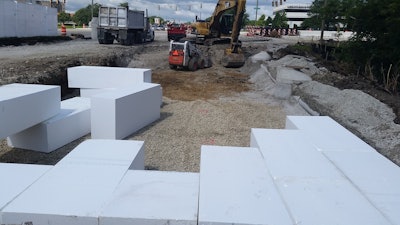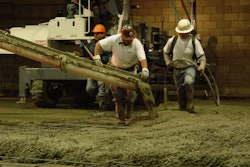
By Jim Nugent, ACH Foam Technologies
A roadway improvement project in Willowbrook, IL, a western suburb of Chicago where State Highway 83 crosses 63rd street in a mostly commercial intersection bordered by a golf course on the northeast side required replacing a box culvert crossing beneath 63rd street that was used to move water runoff from the golf course to a small pond on the south side of the road. On almost every roadway improvement project, one of the first objectives is to keep traffic moving as effectively as possible throughout construction.
“It’s always important to keep the people affected by construction and those travelling on the road happy,” says Anselmo Presisto, P.E., the project manager with Greco Construction who completed the 63rd street improvements. A registered civil engineer working for a contractor, Presisto has more than 25 years of hands on design and construction experience. Like the need to keep traffic flowing, Anselmo also suggests that soil settlement is also a factor.
“With water draining from the golf course to the pond, the soil along the southeast side of 63rd street had been settling for a long time,” continues Presisto. The result was a swampy area dividing the road from the pond and stabilizing the roadway base would require new fill material. Presisto was a bit surprised to see a line item for a product he’d never used before as Greco was putting their bid together. Foam-Control expanded polystyrene (EPS) geofoam, was specified as a structural fill to stabilize the area between the pond and the road. Presisto adds that as far as he knows, Greco Construction hadn’t worked with the geofoam blocks either, despite having been in business for more than 70 years.
“I’ll admit to being skeptical of putting a road on top of two layers of foam blocks,” says Presisto, “but the ACH Foam Technologies’ representatives were able to show me a lot of similar applications that were supporting much more weight than our project.” Like many first-time geofoam users, Presisto was amazed by its compressive strength. At about 1% the weight of traditional earth materials, ACH Foam Technologies’ Foam-Control Geofoam is a cellular plastic material with a compressive resistance up to 18.6 psi at 1% deformation making it an ideal in-fill solution for roadway improvements with settlement issues. Greco ultimately selected ACH Foam Technologies’ Foam-Control EPS 19 Geofoam after looking at several different products and calculating the logistics of the project.
“ACH Foam Technologies had better lead times and more product availability,” say Presisto who was working with a tight 60-day schedule and needed to be sure there would be no material shortage delays. Beyond availability and the price, ACH Foam’s technical assistance really made Presisto comfortable with his decision. During the ordering process, an installation design pattern was developed for the length of the fill using 24-inch by 40-inch by 96-inch Foam-Control EPS Geofoam blocks. As a first-time user, Presisto wanted a little extra confidence in the structural assembly and felt good knowing that his ACH Foam representative would be on site during installation.
“Building the work was very easy with the geofoam,” continues Presisto. “We excavated the area and then put in the subbase and laid in the geofoam blocks by hand.” He reports that his team was able to lay the first 600 cubic yards of geofoam in just a few hours. ACH Foam supplied a hot wire cutter to trim pieces when needed and Greco ended up with very little waste. As the initial installation of geofoam was nearing completion, Presisto was so pleased with the product that he quickly suggested it to engineers as a solution for an independent challenge that arose in the field.
In the section of the work where the drainage channel was being improved, the design called for filling around the box culvert with lightweight concrete. When water table issues were discovered the concrete’s longer cure time was going to extend the construction schedule by at least seven days. Presisto suggested the geofoam as a lightweight fill that would allow construction to proceed unimpeded. Since the ACH Foam Technologies representative was available when the challenge was discovered understanding the technical specifications of the various types of geofoam was simple and new material was quickly delivered. The hot wire cutter was used to precisely shape blocks and a rebar lattice was assembled over the foam. Construction of the overall project was completed on schedule without additional cost.
“It was a great first experience with a very useful product,” says Presisto, who is sure he’ll come across many more challenges that can be solved with an EPS geofoam infrastructure most people will never see.


















